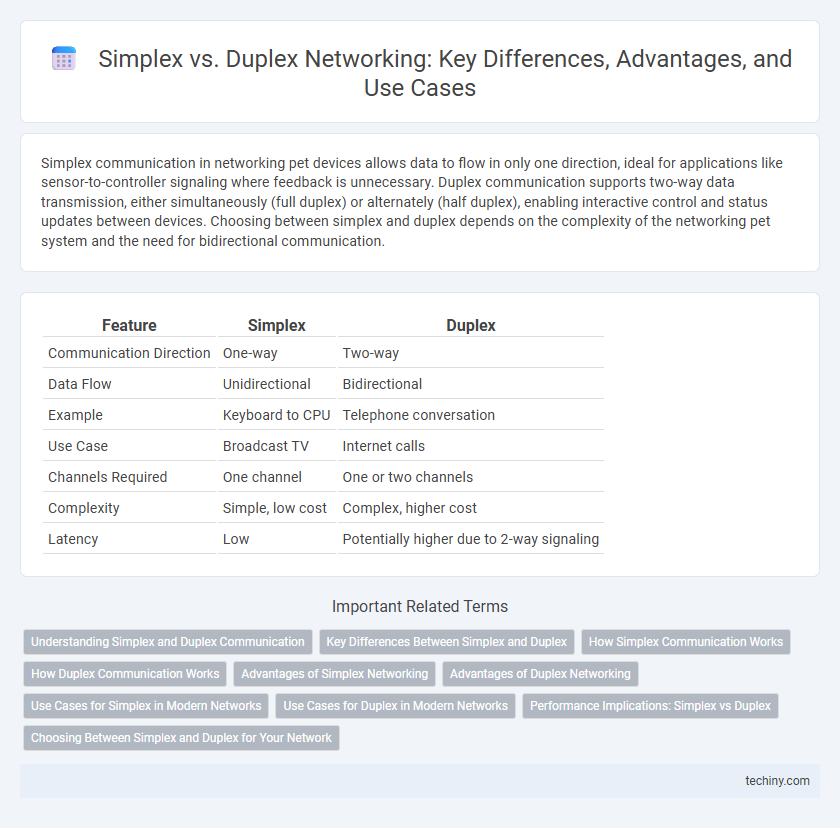Simplex communication in networking pet devices allows data to flow in only one direction, ideal for applications like sensor-to-controller signaling where feedback is unnecessary. Duplex communication supports two-way data transmission, either simultaneously (full duplex) or alternately (half duplex), enabling interactive control and status updates between devices. Choosing between simplex and duplex depends on the complexity of the networking pet system and the need for bidirectional communication.
Table of Comparison
| Feature | Simplex | Duplex |
|---|---|---|
| Communication Direction | One-way | Two-way |
| Data Flow | Unidirectional | Bidirectional |
| Example | Keyboard to CPU | Telephone conversation |
| Use Case | Broadcast TV | Internet calls |
| Channels Required | One channel | One or two channels |
| Complexity | Simple, low cost | Complex, higher cost |
| Latency | Low | Potentially higher due to 2-way signaling |
Understanding Simplex and Duplex Communication
Simplex communication allows data transmission in only one direction, such as in keyboard-to-computer signals, making it suitable for scenarios where feedback is unnecessary. Duplex communication supports bidirectional data flow, enabling devices to send and receive information simultaneously in full-duplex systems or alternately in half-duplex setups. Understanding the distinction between simplex and duplex modes is crucial for designing effective network protocols and optimizing communication efficiency.
Key Differences Between Simplex and Duplex
Simplex communication transmits data in only one direction, making it ideal for applications like keyboard to CPU or TV broadcasts where feedback is unnecessary. Duplex communication supports two-way data transmission, divided into half-duplex (one direction at a time) and full-duplex (simultaneous two-way), crucial for devices such as telephones and network switches. The key differences lie in data flow direction, complexity, and use cases, with simplex offering simpler design but limited interaction, while duplex enables interactive, real-time communication.
How Simplex Communication Works
Simplex communication allows data to flow in only one direction, from the sender to the receiver, without any capability for the receiver to send data back. This mode relies on a single communication channel where the transmitter continuously sends signals, such as in broadcast television or keyboard-to-computer input. Devices operating in simplex mode are ideal for applications where feedback is unnecessary, ensuring straightforward and efficient data transmission.
How Duplex Communication Works
Duplex communication allows simultaneous two-way data transmission between devices, enhancing network efficiency by enabling devices to send and receive signals at the same time. Full duplex systems use separate channels or frequencies for sending and receiving, reducing collisions and latency compared to simplex or half duplex modes. This method is essential in modern networking technologies such as Ethernet and telephony, where continuous bidirectional communication is required.
Advantages of Simplex Networking
Simplex networking offers the advantage of a straightforward and cost-effective communication method, enabling data transmission in only one direction without the complexity of collision management. This simplicity reduces hardware requirements and minimizes potential errors, making it ideal for applications like keyboard-to-computer or monitor outputs. The reliability of unidirectional flow ensures consistent and uninterrupted signal delivery, which is crucial in scenarios where feedback is unnecessary.
Advantages of Duplex Networking
Duplex networking enables simultaneous two-way communication, significantly increasing data transmission efficiency compared to simplex systems that allow only one-way data flow. This capability reduces latency and improves real-time interaction, which is essential for applications like video conferencing and online gaming. Enhanced error detection and correction mechanisms in duplex systems ensure reliable and robust network performance.
Use Cases for Simplex in Modern Networks
Simplex communication is ideal for situations where data flows in a single direction, such as keyboard to CPU signals or sensor data transmission in monitoring systems. This one-way communication model reduces complexity and cost, making it suitable for applications like broadcast radio, TV transmissions, and telemetry in industrial automation. Simplex systems provide reliable and efficient data delivery in environments where feedback or acknowledgment is unnecessary.
Use Cases for Duplex in Modern Networks
Duplex communication enables simultaneous two-way data transmission, making it essential for real-time applications like video conferencing, VoIP, and online gaming in modern networks. Full duplex systems enhance network efficiency by allowing devices to send and receive data concurrently, reducing latency and improving overall bandwidth utilization. Ethernet and Wi-Fi technologies commonly implement duplex modes to support high-speed, interactive communication required in enterprise and consumer environments.
Performance Implications: Simplex vs Duplex
Simplex communication transmits data in only one direction, which limits network throughput and slows performance in applications requiring two-way interaction. Duplex communication, either half-duplex or full-duplex, allows simultaneous or alternating bi-directional data flow, significantly improving network efficiency and reducing latency. Full-duplex systems optimize bandwidth utilization by enabling concurrent sending and receiving of data, making them ideal for high-performance network environments.
Choosing Between Simplex and Duplex for Your Network
Choosing between simplex and duplex communication depends on the specific network requirements. Simplex offers one-way data transmission ideal for sensors or broadcast systems, while duplex supports two-way communication necessary for interactive applications like video calls or online gaming. Evaluating factors such as bandwidth, latency, and communication control helps determine the optimal mode for network efficiency and reliability.
Simplex vs Duplex Infographic

 techiny.com
techiny.com